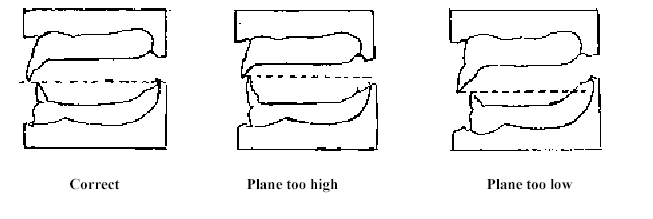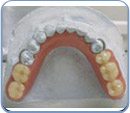
- •Ministry of Public Health of Ukraine Higher State Educational Establishment of Ukraine
- •Actuality of the theme:
- •2. Specific objectives:
- •3.Basic level of training.
- •4. Tasks for independent work during preparation to practical classes.
- •4.1.Theoretical questions to the lesson:
- •4.2. Practical tasks that are performed in class:
- •Arrangement of artificial teeth
- •1. Maxillary anterior teeth
- •2. Mandibular anterior teeth
- •3. Arch form
- •7. Recommended literature.
3. Arch form
Anterior teeth are set to follow the arch form of the patient's residual ridges. The incisal edges of the anterior teeth should be set to correspond to the shape of the arch.
A square arrangement is indicated for a square-shaped maxillary residual ridge, a tapering arrangement for a tapering ridge form, and an ovoid arrangement for an ovoid arch.
ARRANGEMENT OF POSTERIOR TEETH
The posterior teeth are arranged primarily for function and to a lesser extent for
esthetics.
1. Esthetic criteria
The shape of the arch and the height of the occlusal plane affect posterior esthetics. A tooth arrangement which is too wide posteriorly will give the appearance of too many teeth in the mouth. If the teeth are arranged too far toward the tongue or palate, there will be a dark space between the cheek and the teeth when the patient talks or smiles.
Therefore, the arch width of the posterior teeth must harmonize with the width of the patient's face. This width, in turn, is related to the width of the jaws supporting the soft tissues of the face.
The occlusal plane must be level with the incisal edges of the anterior teeth. If it is too low, or too high, the patient will not look natural and also will have difficulty masticating. Remember, the posterior teeth should not appear longer than the anterior teeth when the patient smiles.
2. Functional criteria
The placement of posterior teeth for function may be divided into three parts, although all of these are involved, as each tooth is set. These parts are as follows: a) the height and the orientation of the occlusal plane,
b) the buccolingual relationship of the teeth to the ridge, and
c) the relationship of the teeth to their antagonists.
a. The height of the occlusal plane:
The height of the occlusal plane anteriorly is determined by the placement of the anterior teeth. Posteriorly, it terminates two-thirds of the way up the retromolar pad.
The occlusal plane is located, in general, halfway between the maxillary and
mandibular ridges.
NOTE: When the casts are related on the articulator in centric relation, and have the correct vertical dimension, two generalizations will serve as a guide to the proper division of the interarch distance by the teeth.
1) Teeth generally divide the interarch distance in half.
2) The incisal edge of the mandibular central lines on a plane which parallels the
mandibular ridge crest and intersects the retromolar pad at two-thirds of its height.

b. The buccolingual relation of the teeth to the ridge.
The central fossa of the mandibular first molar should be over the center of the crest of the mandibular ridge. This relationship is necessary to prevent unfavorable leverages, which would cause the denture to tip and to prevent crowding of the tongue which would cause the patient to dislodge the denture.
c. The relationship of the teeth to each other
The relationships of the teeth in maximum intercuspation are very specific. Centric relation is equal to maximum intercuspation in complete denture patients.
1) The maxillary teeth overlap the mandibular teeth horizontally.
2) The long axis of each maxillary tooth is distal to that of the corresponding mandibular tooth.
3) Each tooth in both arches is opposed by two teeth, except the mandibular central incisor and the maxillary second molar.
Arranging the Maxillary Teeth:
Keep in mind the following principles:
The more buccally the tooth is located, the less stable the denture.
The tooth is not placed any further buccally than the denture border.
 The
line previously drawn on the mandibular wax rim locates the position
of the mandibular teeth. The maxillary teeth are arranged in their
most favorable position to the maxillary ridge and in a way to also
provide the most favorable occlusal contacts.
The
line previously drawn on the mandibular wax rim locates the position
of the mandibular teeth. The maxillary teeth are arranged in their
most favorable position to the maxillary ridge and in a way to also
provide the most favorable occlusal contacts.
The central fossa of the mandibular molar should be over the middle of the mandibular ridge crest.
a. Place the right maxillary first premolar with its long axis at right angles to the occlusal plane. The buccal and lingual cusps should contact the metal occlusal plane.
b. Place the right maxillary second premolar in like manner. Align the buccal surfaces of the premolars and the canine with the edge of metal or plastic occlusal plane template.
c. The mesiobuccal and mesiolingual cusps of the right maxillary first molar touch the occlusal plane. The distobuccal cusp is raised about 1/2 mm and the distolingual cusp is raised about 1/2 to 3/4 mm above the occlusal plane.
d. All of the cusps of the second molar are raised from the occlusal plane following the position of the first molar. The mesiobuccal cusp should be about 1 mm from the occlusal plane.
e. Follow the same procedure in placing the posteriors on the opposite side.
This is an average arrangement and modifications should be made as individual conditions indicate.
A fter
placing artificial teeth technician cleans up the wax and prepares
the denture for the try-in appointment, removes all wax from the
teeth with the Roach carver. Technician flames the wax to smooth
it, carves the denture bases to realistically resemble the supporting
structures of a person who has teeth, recreates gingival crevices and
canine prominences in the wax using the Roach carver. Then
technician flames the wax to smooth, stipple the tissue surface with
a tooth brush or Robinson bristle brush to further simulate reality.
Psychologically, the patient is more likely to accept a natural
looking, neatly waxed trial denture than a messy, poorly waxed
approximation of the completed denture.
fter
placing artificial teeth technician cleans up the wax and prepares
the denture for the try-in appointment, removes all wax from the
teeth with the Roach carver. Technician flames the wax to smooth
it, carves the denture bases to realistically resemble the supporting
structures of a person who has teeth, recreates gingival crevices and
canine prominences in the wax using the Roach carver. Then
technician flames the wax to smooth, stipple the tissue surface with
a tooth brush or Robinson bristle brush to further simulate reality.
Psychologically, the patient is more likely to accept a natural
looking, neatly waxed trial denture than a messy, poorly waxed
approximation of the completed denture.
After this procedure waxed areas should be neat, clean, smooth, and properly festooned to simulate the natural healthy dentition. No wax on occlusal surfaces of teeth or under record base. Articulator and casts should be clean.
Materials for self-control:
Tests for self-control (tables, diagrams, drawings, graphs)
Draw a the types of artificial denture teeth.
advantages and disadvantages of various artificial denture teeth.
Make table with rules for selecting and arrangement of artificial denture teeth.
